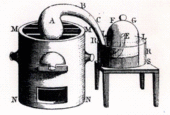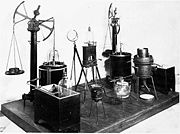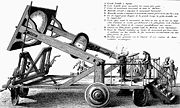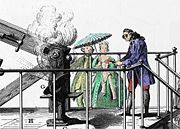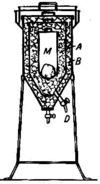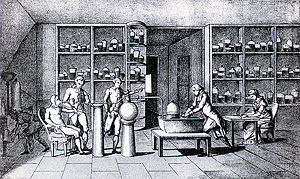Antoine Lavoisier
2008/9 Schools Wikipedia Selection. Related subjects: Chemists
| Antoine Lavoisier | |
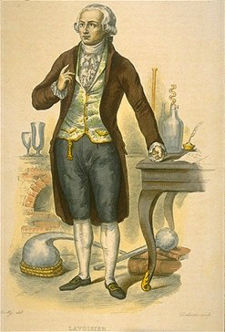 "Father of modern chemistry"
|
|
| Born | August 26, 1743 Paris, France |
|---|---|
| Died | May 8, 1794 (aged 50) Paris, France |
| Occupation | Chemist, economist, nobleman |
Antoine-Laurent de Lavoisier ( August 26, 1743 – May 8, 1794; pronounced [ɑ̃ˈtwan lɔˈʁɑ̃ də la.vwaˈzje]), the father of modern chemistry, was a French nobleman prominent in the histories of chemistry, finance, biology, and economics. He stated the first version of the law of conservation of mass, recognized and named oxygen (1778) and hydrogen (1783), disproved the phlogiston theory, introduced the metric system, wrote the first extensive list of elements, and helped to reform chemical nomenclature. He was also an investor and administrator of the " Ferme Générale" a private tax collection company; chairman of the board of the Discount Bank (later the Banque de France); and a powerful member of a number of other aristocratic administrative councils. All of these political and economic activities enabled him to fund his scientific research. However, because of his prominence in the pre-revolutionary government in France, he was beheaded at the height of the French Revolution.
Early life
Born to a wealthy family in Paris, Antoine Laurent Lavoisier inherited a large fortune at the age of five with the passing of his mother. He attended the College Mazarin from 1754 to 1761, studying chemistry, botany, astronomy, and mathematics. His education was filled with the ideals of the French Enlightenment of the time, and he felt fascination for Maquois's dictionary. From 1761 to 1763, he studied some law at the University of Paris where he received his Bachelor of Law in 1763. At the same time, he continued attending lectures in the natural sciences. Lavoisier's devotion and passion for chemistry was largely influenced by Étienne Condillac, a prominent French scholar of the 18th century. His first chemical publication appeared in 1764. In collaboration with Jean-Étienne Guettard, Lavoisier worked on a geological survey of Alsace-Lorraine in 1767. At the age of 25, he was elected a member of the French Academy of Sciences, France's most elite scientific society, for an essay on street lighting and in recognition for his earlier research. In 1769, he worked on the first geological map of France.
In 1771, Lavoisier married the 13-year-old Marie-Anne Pierrette Paulze, the daughter of a co-owner of the Ferme. Over time, she proved to be a scientific colleague to her husband. She translated documents from English for him, including Richard Kirwan's Essay on Phlogiston and Joseph Priestley's research. She created many sketches and carved engravings of the laboratory instruments used by Lavoisier and his colleagues. She also edited and published Lavoisier’s memoirs (whether any English translations of those memoirs have survived is unknown as of today) and hosted parties at which eminent scientists discussed ideas and problems related to chemistry.
Contributions to chemistry
Research on gases, water, and combustion
Some of Lavoisier's most important experiments were in thermodynamics and the nature of combustion, or burning. Through these experiments, he demonstrated that burning is a process that involves the combination of a substance with oxygen. (He gave this gas its name, which means "acid former," incorrectly believing that all acids had to contain it). Lavoisier also demonstrated the role of oxygen in the rusting of metal, as well as oxygen's role in animal and plant respiration. Working with Pierre-Simon Laplace, Lavoisier conducted experiments that showed that respiration was essentially a slow combustion of organic material using inhaled oxygen. Lavoisier's explanation of combustion disproved the phlogiston theory, which postulated that materials released a substance called phlogiston when they burned.
Lavoisier also discovered that Henry Cavendish's 'inflammable air', which Lavoisier had termed hydrogen (Greek for "water-former"), combined with oxygen to produce a dew, as Joseph Priestley had reported, which appeared to be water. Lavoisier's work was partly based on the research of Priestley. However, he tried to take credit for Priestley's discoveries. This tendency to use the results of others without acknowledgment, then draw conclusions of his own, is said to be characteristic of Lavoisier. In "Sur la combustion en général" ("On Combustion in general," 1777) and "Considérations Générales sur la Nature des Acides" ("General Considerations on the Nature of Acids," 1778), he demonstrated that the "air" responsible for combustion was also the source of acidity. In 1779, he named this part of the air "oxygen" (Greek for "becoming sharp" because he claimed that the sharp taste of acids came from oxygen), and the other "azote" (Greek for "no life"). In "Réflexions sur la Phlogistique" ("Reflections on Phlogiston," 1783), Lavoisier showed the phlogiston theory to be inconsistent.
Pioneer of stoichiometry
Lavoisier's researches included some of the first truly quantitative chemical experiments. He carefully weighed the reactants and products in a chemical reaction, which was a crucial step in the advancement of chemistry. He showed that, although matter can change its state in a chemical reaction, the quantity of matter is the same at the end as at the beginning of every chemical change. These experiments supported the law of conservation of mass, which Lavoisier was the first to state, although Mikhail Lomonosov (1711-1765) had previously expressed similar ideas in 1748 and proved them in experiments. Others who anticipated the work of Lavoisier include Joseph Black (1728-1799), Henry Cavendish (1731-1810), and Jean Rey (1583-1645).
Analytical chemistry and chemical nomenclature
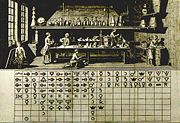
Lavoisier investigated the composition of water and air, which at the time were considered elements. He determined that the components of water were oxygen and hydrogen, and that air was a mixture of gases, primarily nitrogen and oxygen. With the French chemists Claude-Louis Berthollet, Antoine Fourcroy and Guyton de Morveau, Lavoisier devised a systematic chemical nomenclature. He described it in Méthode de nomenclature chimique (Method of Chemical Nomenclature, 1787). This system facilitated communication of discoveries between chemists of different backgrounds and is still largely in use today, including names such as sulfuric acid, sulfates, and sulfites.
Lavoisier's Traité Élémentaire de Chimie (Treatise of Elementary Chemistry, 1789, translated into English by Scotsman Robert Kerr) is considered to be the first modern chemistry textbook. It presented a unified view of new theories of chemistry, contained a clear statement of the law of conservation of mass, and denied the existence of phlogiston. This text clarified the concept of an element as a substance that could not be broken down by any known method of chemical analysis, and presented Lavoisier's theory of the formation of chemical compounds from elements.
His Traité Élémentaire contained a list of elements that included oxygen, nitrogen, hydrogen, phosphorus, mercury, zinc, and sulfur. His list, however, also included light and caloric, which he incorrectly believed to be material substances.
While many leading chemists of the time refused to accept Lavoisier's new ideas, the Traité Élémentaire was sufficiently sound to convince the next generation.
Legacy
Lavoisier's fundamental contributions to chemistry were a result of a conscious effort to fit all experiments into the framework of a single theory. He established the consistent use of the chemical balance, used oxygen to overthrow the phlogiston theory, and developed a new system of chemical nomenclature which held that oxygen was an essential constituent of all acids (which later turned out to be erroneous). Lavoisier also did early research in physical chemistry and thermodynamics in joint experiments with Laplace. They used a calorimeter to estimate the heat evolved per unit of carbon dioxide produced, eventually finding the same ratio for a flame and animals, indicating that animals produced energy by a type of combustion reaction.
Lavoisier also contributed to early ideas on composition and chemical changes by stating the radical theory, believing that radicals, which function as a single group in a chemical process, combine with oxygen in reactions. He also introduced the possibility of allotropy in chemical elements when he discovered that diamond is a crystalline form of carbon.
However, much to his professional detriment, Lavoisier actually discovered no new substances, devised no really novel apparatus, and worked out no improved methods of preparation. He was essentially a theorist, and his great merit lay in the capacity of taking over experimental work that others had carried out--without always, unfortunately, adequately recognizing their claims--and by a rigorous logical procedure, reinforced by his own quantitative experiments, of expounding the true explanation of the results. He completed the work of Black, Priestley and Cavendish, and gave a correct explanation of their experiments.
Overall, his contributions are considered the most important in advancing chemistry to the level reached in physics and mathematics during 18th century.
Contributions to biology
Lavoisier used a calorimeter to measure heat production as a result of respiration in a guinea pig. The outer shell of the calorimeter was packed with snow, which melted to maintain a constant temperature of 0 °C around an inner shell filled with ice. The guinea pig in the centre of the chamber produced heat which melted the ice. The water that flowed out of the calorimeter was collected and weighed. Lavoisier found that 1 kg of melted ice corresponded to 80 kcal of heat production by the guinea pig. Lavoisier concluded, "la respiration est donc une combustion", that is, respiratory gas exchange is a combustion, like that of a candle burning.
Law and politics
Lavoisier received a law degree and was admitted to the bar, but never practiced as a lawyer. He did become interested in French politics, and at the age of 26 he obtained a position as a tax collector in the Ferme Générale, a tax farming company, where he attempted to introduce reforms in the French monetary and taxation system to help the peasants. While in government work, he helped develop the metric system to secure uniformity of weights and measures throughout France.
Final days, execution, and aftermath
As one of twenty-eight French tax collectors and a powerful figure in the unpopular Ferme Générale, Lavoisier was branded a traitor during the Reign of Terror by French Revolutionists in 1794. Lavoisier had also intervened on behalf of a number of foreign-born scientists including mathematician Joseph Louis Lagrange, granting them exception to a mandate stripping all foreigners of possessions and freedom. Lavoisier was tried, convicted, and guillotined on May 8 in Paris, at the age of 50.
Lavoisier was actually one of the few liberals in his position. One of his actions that might have sealed his fate was a clash a few years earlier with the young Jean-Paul Marat whom he dismissed curtly after being presented with a preposterous 'scientific invention', but who subsequently became a leading revolutionary and one of the French Revolution's more extreme "professional common men."
An appeal to spare his life so that he could continue his experiments was cut short by the judge: "The Republic needs neither scientists nor chemists; the trial can not be restrained."
Lavoisier's importance to science was expressed by Lagrange who lamented the beheading by saying: "Cela leur a pris seulement un instant pour lui couper la tête, mais la France pourrait ne pas en produire un autre pareil en un siècle." ("It took them only an instant to cut off his head, but France may not produce another like it in a century.")
One and a half years following his death, Lavoisier was exonerated by the French government. When his private belongings were delivered to his widow, a brief note was included reading "To the widow of Lavoisier, who was falsely convicted."
About a century after his death, a statue of Lavoisier was erected in Paris. It was later discovered that the sculptor had not actually copied Lavoisier's head for the statue, but used a spare head of the Marquis de Condorcet, the Secretary of the Academy of Sciences during Lavoisier's last years. Lack of money prevented alterations being made. The statue was melted down during the Second World War and has not since been replaced. However, one of the main " lycées" (highschools) in Paris and a street in the 8th arrondissement are named after Lavoisier, and statues of him are found on the Hôtel de Ville (illustration, right) and on the façade of the Cour Napoléon of the Louvre.
Selected writings
- Lavoisier, Antoine (1789). Traité élémentaire de chimie, présenté dans un ordre nouveau et d'après les découvertes modernes. Paris: Chez Cuchet.- Reprinted 1965, Bruxelles: Cultures et Civilisations
- Lavoisier, Antoine (1965). Elements of Chemistry. New York: Dover.- Reprint of Robert Kerr's English translation of 1790

